by Bill Benzon
Timothy Morton. Hyperobjects: Philosophy and Ecology after the End of the World. University of Minnesota Press 2013. 229 pp.
This is a strange book, for it is three. There is the book that is easy to praise for its range of topics – quantum mechanics, La Monte Young, global warming, The Matrix, the Prisoner’s Dilemma, for example – and its quasi-virtuoso stylistic versatility. There is, as well, the book that is easy to criticize – though I’m sure some would regard that as too mild a word – for its conceptual instabilities, lapses in logic, and misreading of science.
And there is another book, the one leaking out of the cracks and pores in the first two. That book has the scattered beginnings of a framework in which we can construct a viable approach to the future. That's the book I'm writing about, making this essay as much an interpretation of as a review of Morton's fine Hyperobjects.
Hyperobjects and Objects
Hyperobjects are “things that are massively distributed in time and space relative to humans” (p. 1). What isn’t a hyperobject is an object. Kumquats, automobiles, palm trees, squids, geosynchronous satellites, Olympic records, a promise, a rooster’s crow, these are all objects in the philosophical sense of the word. In the first paragraph of the book Morton lists these examples: the Lago Agrio oil field, Florida Everglades, the biosphere, the Solar System, “the sum total of all the nuclear materials on Earth; or just the plutonium, or the uranium,” Styrofoam, plastic bags, or “the sum of all the whirring machinery of capitalism.”
The philosophical sense of object is not quite the same as the ordinary sense, which tends toward physical things that are neither very large nor very small. Roughly speaking, for Morton and proponents of other object oriented ontology (OOO) – a recent school of Continental philosophy – anything that can be designated by a noun or a noun phrase is an object. Anything. Including, of course hyperobjects.

